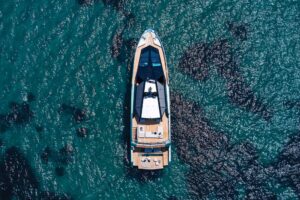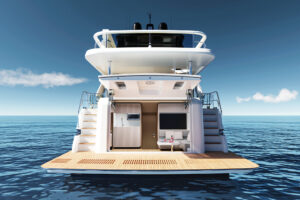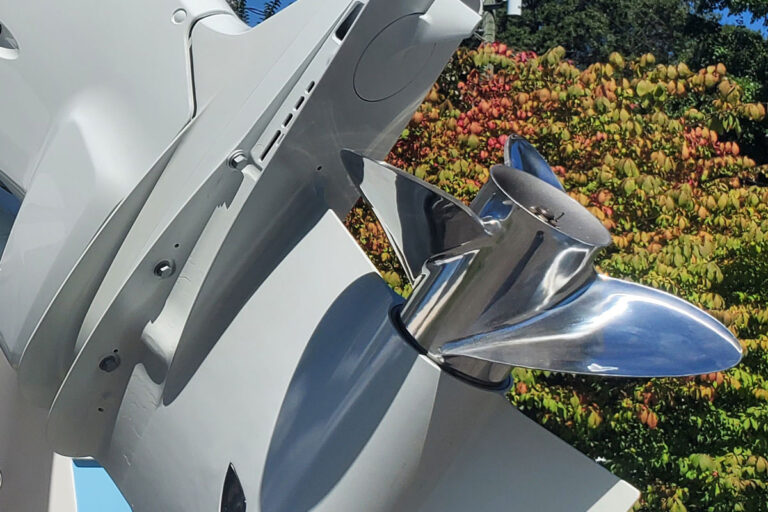
yachting/images/magazine/2005/122005/fea_pershing_525x350.jpg
The life of a boat tester has its ups and downs. You might travel a thousand miles to take a new boat to sea for a trial, and then things turn sour. The weather might not cooperate or something on the engine fails, and you come home empty-handed. So you can imagine my disappointment when I arrived in Fano, on the east coast of Italy, to test something very special, a 115-footer with over 12,000 hp, and found the wind blowing at more than 25 knots. Another wasted journey, I thought.
What I had not appreciated was that this Pershing 115 is a very capable sea boat. “No problem” was the reaction from skipper Darren, so off we went into six-foot waves. Indeed, the boat showed a remarkable disdain for the conditions, although these seas would not allow us to use the full speed potential of this superyacht. A disappointment, but a pleasure to save until later.
When I went out in the prototype 115 last year, it was fitted with just a pair of 3,700 hp MTU diesels, but even then the top speed was a very creditable 42 knots, seriously fast for a 115-footer. This latest version is the first one to be fitted with a 5,000 hp gas turbine to supplement the two big diesels, boosting the speed up to an amazing 55 knots. Imagine 130 tons of boat traveling at close to 65 mph-now that is seriously, seriously fast.
This high top speed isn’t the only thing that’s exciting about the 115. Take the outside color for a start. Pershing has been the pioneer of some innovative modern color schemes, using silver and dark blue. But this boatbuilder has gone one step further with this version: The whole exterior is finished in a metallic silver. You are certainly not going to miss this one in the marina.
Color aside, the gas turbine version looks just like the regular 115 with diesel power, which was disappointing. After all, the gas turbine option adds a cool $3.5 million to the price of the yacht, and for that kind of money, I would want some external signs that my yacht was something extra special. Even the turbine exhaust, usually a very distinctive feature of turbine boats, exits under water so there is no sign of it. There isn’t even a GT (gas turbine) after the name, although Pershing says that it could be added, if you want it.
Whatever your feelings about the proportion of form to function, you are getting a lot of boat for your bucks with this very special 115. Here is performance that is going to take you past virtually everything else on the water. What really impressed me is how very exciting a sea-going yacht this is. We were running 30 knots in six-foot head seas and there wasn’t even enough movement to spill my coffee. Sure, there was a slight amount of slamming as the waves hit the chines, but the bow did not move up and down more than a couple of feet against the horizon. Now that’s impressive.
I cannot recall ever coming across such a combination of excellent rough-sea performance and high speed. Having crossed the Atlantic under power more than a couple of times, I know size counts when it comes to rough seas, but I did not expect anything quite as good as this. Even running downwind, which is so often the Achilles’ heel of fast boats, the performance was just as good, and you could adjust the speed to match the waves for a very comfortable ride. Going this way, 40 knots was a comfortable speed.
Being a Pershing, this yacht is more than just a power package to admire. For instance, another innovation on this version of the 115 is a flybridge. On the prototype the upstairs was simply a very private sun pad, but Pershing has converted it into a full-fledged control station with three helm seats plus a sun bed and loungers behind. Riding up here at speed is a real wind-in-your-hair experience; it is also here that you find the joystick control system that combines water jets and engines to give point-and-go maneuvering. The only snag is that the visibility astern is not very good, which you need when berthing this monster yacht.
Down below, the controls are slightly more conventional. The captain sits with a control panel on each side of his seat, with one diesel engine controller on each. These are point-and-go to a certain extent, but you control each engine individually. From here, the 115 handles like a dream. You can park it with confidence, even in a strong side wind, the powerful bowthruster helping considerably. Facing you is a galaxy of screens with the two center ones for navigation and the two on each side monitoring the engines and controlling the auxiliary systems. It is a lot to keep your eye on when traveling at high speed.
The turbine has its own throttle and control panel, though you can only use this once the boat is traveling at over 20 knots. This is because you have to open a flap that covers the exhaust in the transom, and if you do this at slower speeds, water might run back up the pipe and swamp the turbines, which could be an expensive mistake. Once the turbine is fired up, it then can be clutched in to its own water jet, one that is for thrust only, with no steering or reverse.
Each engine drives through its own Rolls Royce water jet, an installation that breaks new ground by having the jet intakes molded into the hull. Normally the intakes would be fabricated from stainless steel, but because these molded fiberglass intakes are integral with the hull, they give a smoother water flow to the jet, which improves efficiency. Steering with the jets is very quick and precise. The reverse gear is all you might want, but don’t engage it with the turbine running.
As for the rest of the boat, it is impeccably styled, in what might be termed a classical modern look. The interior can be customized to quite a high degree, as was evident in the differences between the one I tested last year and this one. The wood paneling is in straight-grain oak with horizontal stainless steel strip inserts. This metallic is continued in the heads with some stainless steel mosaic and decking, but overall this is a restful, quiet interior-quite a contrast to the exciting performance. The half-height space below and forward of the helm has been used to create a study and TV room. Then there is the usual arrangement of two twins and a VIP cabin plus the full-width master stateroom.
The deck saloon features light cream settees arranged in a circle, with the dining area forward of this. Outside in the cockpit you have another dining area and then a huge sun bed. Another sun bed is on the coach roof above the Jet Ski garage with an additional table and general seating, so you have a lot of options for dining and socializing. The main layout is fully dramatic, but there has also been considerable attention given to small details. For instance, the anchors are enclosed behind doors to maintain the uncluttered lines of the hull.
Pershing has built turbine boats before, and anyone with a long memory will remember Yellow Fly, a 72 Pershing that appeared at the Miami Boat Show some years ago. Tilli Antonelli, the boss of Pershing, describes this new boat as “the best Pershing we have ever built. I certainly have to agree with him about that. I cannot think of a yacht that has had me so excited as this beauty, which is right at the cutting edge of modern fast-yacht technology.
This 115 really is a magnificent motoryacht, combining superb comfort with a performance that is nearly out of this world. Of course, this combination does not come cheap, yet I find it hard to believe that any prospective owner is going to be satisfied with the diesel-powered version once he has been to sea in this one. I am starting to save my pennies, though I fear I have a long, long way to go.
Contact: MarineMax, www.marinemax.com









